Servicios Personalizados
Revista
Articulo
Indicadores
-
 Citado por SciELO
Citado por SciELO -
 Accesos
Accesos
Links relacionados
-
 Citado por Google
Citado por Google -
 Similares en
SciELO
Similares en
SciELO -
 Similares en Google
Similares en Google
Compartir
Boletín Científico. Centro de Museos. Museo de Historia Natural
versión impresa ISSN 0123-3068
Bol. Cient. Mus. Hist. Nat. Univ. Caldas vol.19 no.2 Manizales jul./dic. 2015
https://doi.org/10.17151/bccm.2015.19.2.8
DOI: 10.17151/bccm.2015.19.2.8
DYNAMICS OF Sus scrofa SEMEN QUALITY IN THE WESTERN-CENTRAL REGION OF COLOMBIA*
DINÁMICA DE LA CALIDAD SEMINAL DE Sus scrofa EN EL CENTRO OCCIDENTE COLOMBIANO
Germán Gómez L,1, Henry Mesa,2, Jonatan Sánches-Osorio,3 Francisco Javier Henao.4
* FR: 7-IV-2015, FA: 22-VIII-2015
1 Ph.D. Grupo de investigación Biología de la Producción Pecuaria, Facultad de Ciencias Agropecuarias, Universidad de Caldas. Manizales, Colombia. E-mail: germgolo@ucaldas.edu.co
2 Ph.D. Grupo de investigación Producción Agropecuaria, Facultad de Ciencias Agropecuarias, Universidad de Caldas. Manizales, Colombia. E-mail: hmesa@ucaldas.edu.co
3 Ph.D. Departamento de Medicina y Cirugía Animal, Universidad de Murcia. Murcia, España. E-mail: osorio@um.es
4 Ph.D. Grupo de investigación Biología de la Producción Pecuaria, Facultad de Ciencias Agropecuarias, Universidad de Caldas. Manizales, Colombia. E-mail: fhenao@ucaldas.edu.co
CÓMO CITAR:
GÓMEZ, G., MESA, H., SÁNCHEZ, J., HENAO, F., 2015.- Dynamics of sus scrofa semen quality in the western-central region of Colombia. Bol. Cient. Mus. Hist. Nat. U. de Caldas, 19 (2): 139-153.
Abstract
In order to characterize the dynamics of Sus scrofa (order Artiodactyla, family Suidae) semen quality in the Western-central region of Colombia, information of 1,017 assessments from 177 males from 12 swine farms located between 700 and 2,600 meters above sea level in different inter-tropical systems was collected in the Laboratory of Reproductive Biology at Universidad de Caldas (Colombia) during seven years. The database included the seminal variables: concentration, morphology (head, midpiece and tail), membrane structural integrity (MSI), acrosome integrity (ACRI), and membrane functional integrity (MFI) proximal citoplasmic droplets (PCD), distal citoplasmic droplets (DCD), and total citoplasmic droplets (TCD). Additionally, the racial group of the male (grac): maternal cross (cm), paternal cross (cp), paternal pure (pp), maternal pure (pm) and age group (agegr): young (up to 18 months), mature (19 to 36 months) and old (over 37 months) were registered. Data was explored by estimating descriptive statistics; it was analyzed using a log-linear model consisting of a Poisson regression with a log link function using the PROC GENMOD of SAS (SAS Inst. Cary, NC). The effect of age group and racial group on semen quality variables using a mixed model for repeated measurements in the same boar over time were evaluated. The Spearman correlation coefficients between variables were calculated. The variables: macro, micro and pyriform head; double, eccentric, and thickened midpiece; tail whip; ladder bow; ball and distal reflex showed less than 1% prevalence. The highest values of FMI were found in cm and pp. Males cp, cm and pm do not differ from each other in MFI, but all had higher values than pp. The ACRI in cm was higher than cp, and these higher than pm. Presentation of TCD increased with age, with a higher percentage of PCD in older animals than in younger animals; mature animals showed intermediate values between them. The TCD exceeded 15% of presentation, being always higher for PCD than for GCP. The TCD is negatively correlated with MSI and ARCI, but positively correlated with MFI. The same trend is observed in the correlations with distal cytoplasmic droplets. However, the correlation of proximal droplets with the structural integrity loses significance, though they are negatively correlated with acrosome integrity. Values for MSI, MFI and ACRI, do not limit the quality of the samples in this population.
Key words: boar sperm, semen analysis, semen quality, sperm.
Resumen
Con el fin de caracterizar la dinámica de la calidad seminal en Sus scrofa (orden Artiodactyla, familia Suidae) en el centro-occidente colombiano, durante siete años se recopiló en el Laboratorio de Biología de la Reproducción de la Universidad de Caldas (Colombia), información de 1017 evaluaciones de 177 machos procedentes de 12 planteles porcinos ubicados entre los 700 y 2600 msnm en diferentes sistemas intertropicales. La base de datos incluyó las variables seminales: concentración, morfología (cabeza, pieza intermedia y cola), integridad estructural de la membrana (IEM), integridad acrosómica (IAC), integridad funcional de la membrana (IFM), gotas citoplasmáticas (GC): gotas citoplasmáticas proximales (GCP), gotas citoplasmáticas distales (GCD) y gotas citoplasmáticas totales (GCT), así como información del grupo racial de los machos (grac): cruzado materno (cm), cruzado paterno (cp), puro paterno (pp) y puro materno (pm), y grupo etario (gredad): joven (hasta 18 meses), maduro (19 a 36 meses) y viejo (mayor a 37 meses). Los datos se exploraron mediante la estimación de estadísticos descriptivos, se analizaron usando un modelo log-lineal, consistente en una regresión Poisson con una función de enlace logarítmica mediante el PROC GENMOD de SAS (SAS Inst. Cary, NC). Se evaluó el efecto de grupo etario y grupo racial sobre las variables de calidad seminal usando un modelo mixto para mediciones repetidas en el mismo verraco a través del tiempo. Se calcularon los coeficientes de correlación de Spearman entre las variables seminales. Las variables: cabeza macro, micro y piriforme, tracto intermedio doble, excéntrico y engrosado, cola en látigo, lazo, escalera, ovillo y reflejo distal, presentaron prevalencias inferiores al 1%. La mitad de las dosis de semen diluido recibidas mostraron concentraciones superiores a 35 millones de células ml-1. Los valores más altos de IEM se encontraron en los reproductores cm y pp. Al relacionar la variable IFM con grupo racial, los reproductores cp, pm y cm no presentan diferencias entre sí. La IAC en los cm presentaron un porcentaje mayor que los cp, y estos mayor que los pm. Se aprecia una mayor presentación de GCT a medida que avanza la edad, con un mayor porcentaje de GCP en animales viejos que jóvenes, los animales maduros presentaron valores intermedios entre ellos. Las GCT excedieron el 15% de presentación, siendo siempre mayor la presentación de GCD que GCP. El total de gotas está negativamente correlacionado con la IEM y la IAC, pero positivamente con la IFM, la misma tendencia se observa en la correlaciones de las gotas citoplasmáticas distales; sin embargo, la correlación de las gotas proximales con la integridad estructural pierde fuerza y con la integridad funcional pierde la significancia, aunque están negativamente correlacionadas con la integridad del acrosoma. Los valores para MSI, MFI and ACRI, no limitan la calidad de las muestras de semen en esta población.
Palabras clave: espermatozoides porcinos, análisis de semen, calidad seminal, espermatozoides.
INTRODUCTION
Colombia has an environmental diversity that puts most swine farms through important differences related to altitude above sea level, temperature and humidity, which added to a diversity of factors related to age and racial group of the male, inherent characteristics of the administrative processes of each farm, and most important, lack of knowledge of the dynamics of semen quality under these conditions, hinder the development of programs for the control of fertility and prolificacy. The pig industry in Colombia has not made intensive use of the available technological possibilities to improve reproductive efficiency in boars.
The evaluation of semen quality is the tool that allows making an approximation to the fertilizing potential of an ejaculate in a given time and allows discarding those with low fertility (AMANN, 1989; ARDÓN et al., 2005). In artificial insemination programs it has been shown that the measurement of a single variable is not a reliable indicator of semen quality, being necessary an analysis of as many variables as possible (TURBA et al., 2007). Although some of these variables are used to detect reproductive disorders that generate low fertility, they are not useful to predict healthy boars fertility in which a proportion of abnormal sperm in the ejaculate is accepted (FLOWERS, 2002; SUTKEVICIENE & Z?ILINSKAS, 2004). The use of sperm with low fertilizing capacity in artificial insemination programs, in which between 1,500 and 2,000 doses per male are used in a year (RUTTEN et al., 2000), causes a decrease in the efficiency of services, an increased return to estrus, the early disposal of replacement sows, and, in general, a decreased reproductive efficiency in the farm (KOKETSU & SASAKI, 2008; SAFRANSKI, 2008). Therefore, counting with tools that allow an objective evaluation of semen quality in addition to information of the reproductive behavior of males, allows making a rational and appropriate use of breeding males. The aim of this study was to characterize the dynamics of porcine semen quality in the Western-central region of Colombia.
MATERIALS AND METHODS
At the Universidad de Caldas Reproductive Biology Laboratory, information of 1,017 evaluations obtained from 177 males from 12 swine farms located in the Western-central region of Colombia (Antioquia, Valle del Cauca, Risaralda and Caldas) which are located between 700 and 2,600 meters above sea level in different inter-tropical ecosystems was collected for seven years (27 quarters, from July 2005 to March 2012). The database included the seminal variables: concentration, morphology (head, mid piece and tail), membrane structural integrity (MSI), acrosome integrity (ACRI), and membrane functional integrity (MFI); proximal cytoplasmic droplet, (PCD), distal cytoplasmic droplet (DCD), and total cytoplasmic droplets (TCD). Additionally, males were classified into four racial groups (grac) depending on the information supplied by commercial breeders: maternal cross (cm), paternal cross (cp), paternal pure (pp), maternal pure (pm) and into three age groups (agegr): young (up to 18 months), mature (19 to 36 months) and old (over 37 months).
Seminal evaluation techniques: sperm morphology was assessed in sperm fixed with formaldehyde saline solution (NaCl 2.25 g, 249.25 ml of sterile distilled deionized water, 0.75 ml formaldehyde), using a 400X magnification phase contrast microscope. Abnormalities present in 300 sperm head (loose, macro, micro, pyriform), mid piece (double, bent), tail (short, bent, coiled, loose, looped, and doubled), and cytoplasmic droplets (CD): proximal or distal, were counted. The membrane structural integrity was assessed by staining with eosin nigrosin (E/N), for which 100 spermatozoa were counted in a 400X magnification bright field microscope. The membrane functional integrity was assessed using a short hypo-osmotic swelling test and subsequent fixation in formaldehyde saline solution; positive spermatozoa were identified using a 400X magnification phase contrast microscope after performing 2 counts of 100 sperm each (JOHNSON et al., 2000; PÉREZ-LLANO et al., 2001). The acrosome integrity was assessed by fixation with 2% glutaraldehyde in BTS, the number of sperm with normal apical ridge was recorded after counting 200 spermatozoa in a 400X magnification phase contrast microscope (GADEA et al., 2004). Concentration was measured using Bürkers chamber, temperature was measured with digital thermometer, and pH was measured using a glass electrode meter ( PURSEL et al., 1972; DÍAZ et al., 2009). All counts carried out were expressed as proportions for the final analysis.
Analysis of information: all data was initially screened by estimating descriptive statistics summarized in Tabla 1. Due to the non-normal distribution of the variables, they were analyzed using a log-linear model consisting of a Poisson regression with a logarithmic link function using PROC GENMOD of SAS (SAS Inst. Cary, NC). The effect of age group and racial group on semen quality was assessed using a mixed model for repeated measurements in the same boar over time. Results are reported as least square means ± standard error. The Spearman correlation coefficients were calculated among the seminal variables.
RESULTS
The variables: sperm head (loose, macro, micro, pyriform), mid piece (double, bent), and tail (short, bent, coiled, loose, looped, doubled), had prevalence lower than 1% (results not presented).
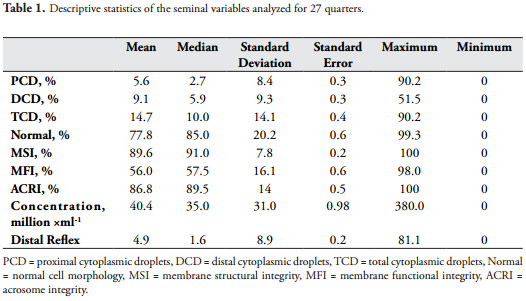
As showed in Table 1, half of the samples of diluted semen showed concentrations greater than 35 million ×ml-1 cells (3.5 × 109 cells per dose of 100 ml), with values exceeding 40 million ×ml-1 cells in the 14 quarter (Figure 1).
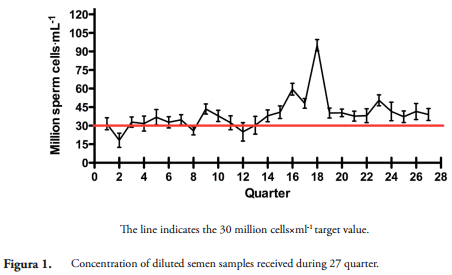
As evidenced in Figure 2, the highest membrane structural integrity values were found in pp and cm males, with MSI values always above 80% during the evaluation period (Figure 3).
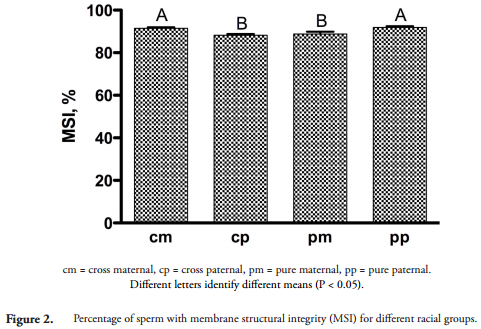
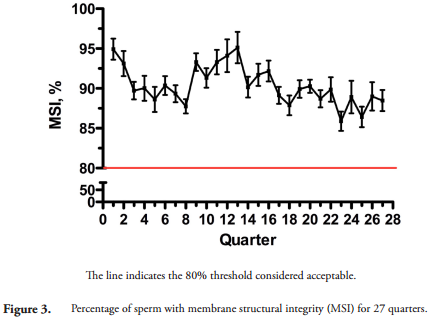
The percentage of functional membrane integrity is shown in Figure 4; this variable remained higher than 50% most of the time during the 27 quarters analyzed.
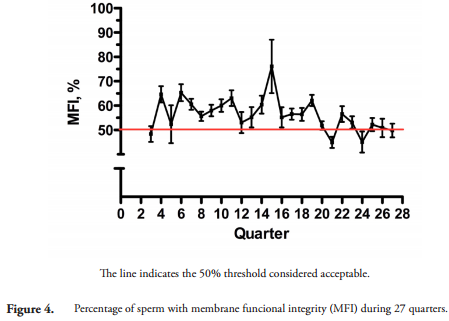
Figure 5 depicts the behavior of MFI and its relationship with racial group. It is evidenced that cp, cm, and pm males do not differ among themselves, but cp and pm values were significantly higher than those of pp.
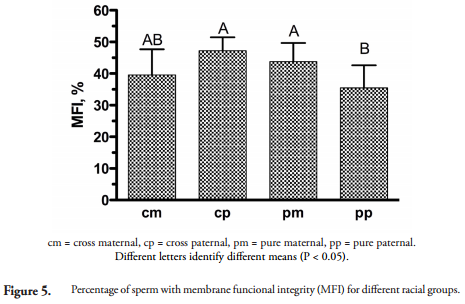
The values of normal morphology sperm is shown in Figure 6; pp animals had a higher percentage of normal cells than other racial groups analyzed, which did not show differences from each other.
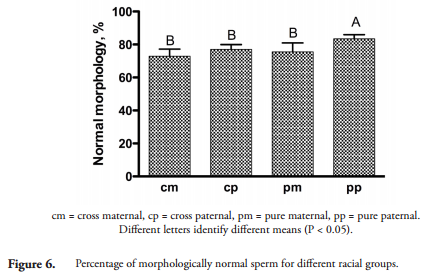
The acrosomal integrity percentage during the time of the study was above 80%, as evidenced in Figure 7. The cm males showed the highest values for ACRI, while pp males showed intermediate values between cp and pm (Figure 8).
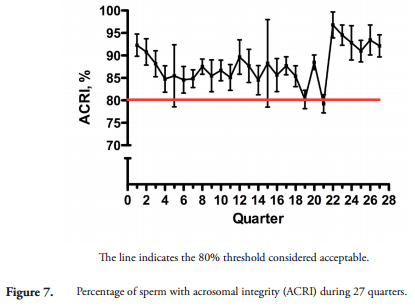
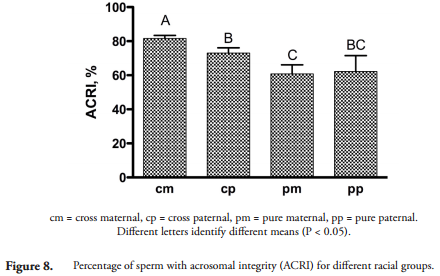
The percentage of total cytoplasmic droplets and its relationship with age is presented in Figure 9; we did not detect significant differences among age groups for this variable.
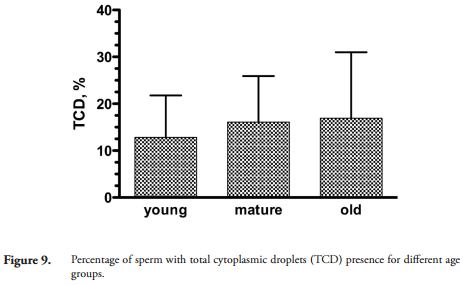
The presentation of proximal cytoplasmic droplets and its relationship with age is presented in Figure 10, which shows a higher PCD percentage in older than younger animals, while mature animals showed intermediate values among them.
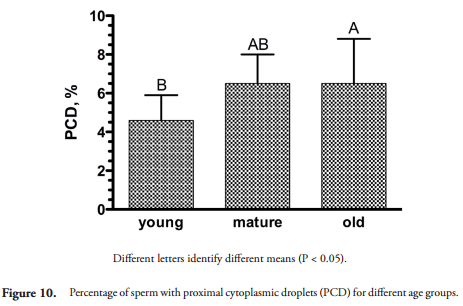
Figure 11, the percentage of samples that would be rejected by excess of total cytoplasmic droplets with different recommended thresholds in the literature can be observed. Even with the most lenient (25%) threshold, almost 20% of the samples had TCD excess.
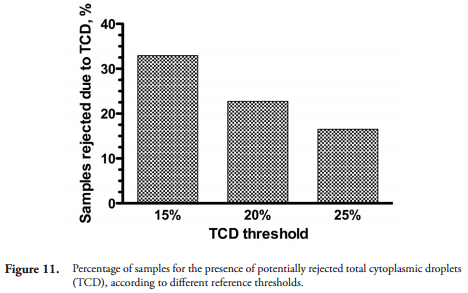
Figure 12 shows DCD, PCD and TCD distribution percentage during the 27 quarters of the analysis. It can be seen how TCD frequently exceeded 15%, a value considered limiting of reproductive performance. Likewise, DCD presentation was always higher than PCD.
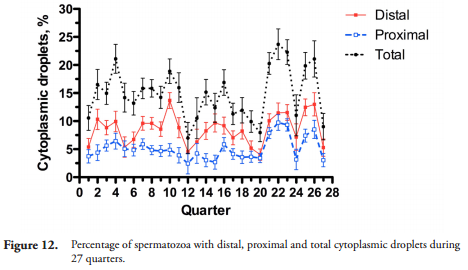
Table 2 presents TDC, DCD and PCD coefficients correlation with normal and with ACRI MSI, MFI. It is noteworthy that TCD is negatively correlated with the membrane structural integrity and acrosome integrity, but positively correlated with the membrane functional integrity. The same trend is observed in the distal cytoplasmic droplets correlations. However, the correlation of proximal droplets functional integrity loses strength and loses significance with functional integrity, even though they are negatively correlated with the acrosome integrity. As expected, the correlations of the number of normal cells with GCT, GCP and GCD are high and negative.
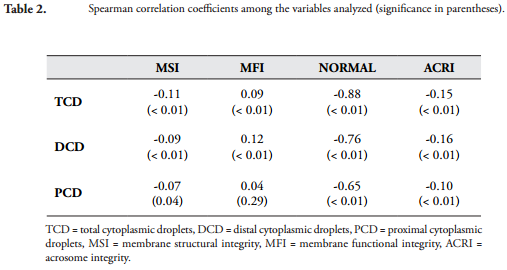
DISCUSSION
The incorporation of artificial insemination in the swine industry makes it necessary to have reliable processes to obtain high quality semen to ensure optimal reproductive performance, as well as information of the limiting variables when using refrigerated semen (TURBA et al., 2007).
The prevalence under 1% for macro, micro and pyriform head; mid piece (double, bent), tail (short, bent, coiled, loose, looped, doubled) makes them irrelevant as determinant quality factors of ejaculates in our study, and are consistent with values reported in a previous work (DRUART et al., 2009). Likewise, the values found for MSI, MFI and ACRI agree with previous reviews (POPWELL & FLOWERS, 2004; LÓPEZ-RODRÍGUEZ, 2012) and are considered not limiting for the quality of the samples in our study.
Half of the diluted semen samples that arrived in the laboratory were found to have concentration higher than 35 million cells ×ml-1, which exceeds the recommended 3 × 109 cells per dose value (ALTHOUSE & LU, 2005; MASENYA et al., 2011). This shows poor quality control in the preparation of doses for artificial insemination, compromising the samples lifetime because of a diminished capacity of the extender to regulate pH and osmotic pressure and to maintain cellular metabolism and microbial growth inhibition (FLOWERS, 2002; SMITAL, 2010).
In this study, a relationship of racial group with MSI was found (the highest values were found in cm and pp males); however, other studies (OSORIO-SERNA et al., 2007) did not find differences when comparing Large White pigs with Kolbroek pigs. Boars cp and pm showed higher MFI than pp males, while other studies found increased hypotonic resistance of sperm in Pietrain than in Large White pigs (POPWELL & FLOWERS, 2004).
Similar to these results, an evaluation of three racial groups in the Czech Republic identified increased ACRI in breeding males from paternal origin (PIZZI et al., 2005). Additionally, ACRI values in cm presented a higher percentage than in cp, and those were greater than pm, similar to other reports in which the normal acrosomes percentage was higher in maternal line than in paternal lines (ROBINSON & BUHR, 2005; WYSOKINSKA & KONDRACKI, 2013). Similarly to our results, a positive effect of crossing has been reported in Hampshire pigs (KONDRACKI et al., 2005). Genetic variability for semen quality (motility, morphology, duration and ability to fertilize) is questioned because many environmental factors make it difficult to determine its genetic basis. However, semen quality is commercially important and must be the subject of intense research to determine its heritability and its inclusion in selection schemes (ALTHOUSE, 1998). It has been demonstrated that age affects the quality of the ejaculate (LOVERCAMP et al., 2007), which is consistent with our finding of a GCP higher percentage in older than younger animals. In our analysis, TCD prevalence was close to 15%, a value considered limiting for reproductive performance (FISCHER et al., 2005; HENAO et al., 2010). Likewise, DCD presentation was always higher than that of PCD, which is consistent with previous reports (FRESHMAN, 2002; LÓPEZ-RODRÍGUEZ, 2012). It is pertinent to note that the presentation of PCD in sperm is associated with mitochondria structural disorders, which can lead to mobility alterations (BRIZ et al., 1995). The negative and highly significant correlations of cytoplasmic droplets with MSI can be attributed to the hydrolytic enzyme activity that immature sperm possess (KUSTER et al., 2004). Non-significant correlations of CD presentations with ACRI, and TCD and PCD with MSI, could be attributed to the regional independence of the plasmatic membrane and the sperm head (JOHNSON et al., 2000). In addition, the correlation between the DCD and MFI, although low, was positive and significant, which may represent enzymatic processes associated with the factors that affect sperm maturation during passage through the epididymis, which alter the osmolarity pattern (KUSTER et al., 2004).
CONCLUSIONS
The values of morphologically normal spermatozoa with membrane structural integrity, functional membrane integrity, and acrosome integrity were always higher than the threshold considered acceptable; likewise, the variables: sperm head (loose, macro, micro, pyriform), mid piece (double, bent), tail (short, bent, coiled, loose, looped, doubled) had very low prevalence, making them irrelevant in semen quality control in the Western-central region of Colombia. Half of the diluted semen samples that arrived in the laboratory were found to exceed the desirable concentration, which shows poor quality control in the preparation of doses for artificial insemination.
The cytoplasmic droplets are the most frequent morphological alteration in semen samples from farms in the Western-central region of Colombia. A higher presentation of cytoplasmic droplets was found as age increased; furthermore, the distal cytoplasmic droplets presentation was always higher than proximal cytoplasmic droplets. In this study, cytoplasmic droplets and structural integrity of the membrane and the acrosome are negatively correlated.
On the other hand, a positive correlation between cytoplasmic droplets and the functional integrity of the membrane was detected. These associations suggest that it is possible to make different combinations of variables in a semen quality control process to determine the number of functionally competent sperm in an attempt to obtain quick and efficient reliable predictors of the fertilizing capacity of an ejaculate. This opens the possibility to perform the quality control before the material is used in a large number of females, with the easily foreseen economic benefits in such scheme.
So far, the causes and effects of GCs on the fertilizing capacity of sperm in Colombia are not clearly understood. The need for a more detailed follow-up of semen quality and associated factors will pinpoint the associations between in vitro results and the reproductive and productive performance of swine farms.
ACKNOWLEDGEMENTS
Project financed by Vicerrectoría de Investigaciones y Posgrados at Universidad de Caldas (Colombia).
REFERENCES
ALTHOUSE, G.C., 1998.- Cytoplasmic droplets on boar sperm cells. Swine Health and Production, 6 (3): 128. [ Links ]
ALTHOUSE, G.C. & LU, K.G., 2005.- Bacteriospermia in extended porcine semen. Theriogenology, 63 (2): 573-584. doi: 10.1016/j.theriogenology.2004.09.031 [ Links ]
AMANN, R.P., 1989.- Can the Fertility Potential of a Seminal Sample Be Predicted Accurately? Journal of andrology, 10 (2): 89-98. [ Links ]
ARDÓN, F., EVERT, M., BEYERBACH, M., WEITZE, K.F. & WABERSKI, D., 2005.- Accesory Sperm: A Biomonitor of Boar Sperm Fertilization Capacity. Theriogenology, 63: 1891-1901. [ Links ]
BRIZ, M., BONET, S., PINART, B., EGOZCUE, F. & CAMPS, R., 1995.- Comparative Study of Boar Sperm Coming From the Caput, Corpus, and Cauda Regions of the Epididymis. Journal of andrology, 16 (2): 175-188. [ Links ]
DÍAZ, F.O., MESA, H., VALENCIA MEJÍA, J.G., GÓMEZ LONDOÑO, G. & HENAO URIBE, F.J., 2009.- Evaluación de la integridad acrosomal y la funcionalidad bioquímica de la membrana espermática en cerdos reproductores con gotas citoplásmicas persistentes. Revista Cientifica, Facultad de Ciencias Veterinarias, Universidad del Zulia, 19 (5): 500-505. [ Links ]
DRUART, X., GATTI, J.-L., HUET, S., DACHEUX, J.-L. & HUMBLOT, P., 2009.- Hypotonic resistance of boar spermatozoa: sperm subpopulations and relationship with epididymal maturation and fertility. Reproduction, 137: 205-213. [ Links ]
FISCHER, K.A., VAN LEYEN, K., LOVERCAMP, K.W., MANANDHAR, G., SUTOVSKY, M., FENG, D., .SUTOVSKY, P., 2005.- 15-Lipoxygenase is a component of the mammalian sperm cytoplasmic droplet. Reproduction, 130 (2): 213-222. doi: 10.1530/rep.1.00646 [ Links ]
FLOWERS, W., 2002.- Increasing Fertilization Rate of Boars: Influence of number and Quality of Spermatozoa Inseminated. Animal Science, 80 (Suppl.1): E47-E53. [ Links ]
FRESHMAN, J.L., 2002.- Semen collection and evaluation. Clin Tech Small Anim Pract, 17 (3): 104-107. doi: 10.1053/svms.2002.34326 [ Links ]
GADEA, J., SELLES, E. & MARCO, M.A., 2004.- The predictive value of porcine seminal parameters on fertility outcome under commercial conditions. Reproduction in domestic animals = Zuchthygiene , 39 (5): 303-308. doi: 10.1111/j.1439-0531.2004.00513.x [ Links ]
HENAO, F.J., VALENCIA, J., DÍAZ, O. & RANGEL, M., 2010.- Efecto de la adición de plasma seminal sobre la eliminación de gotas citoplásmicas en semen de Sus scrofa (Linnaeus, 1758). Boletin Científico Museos Historia Natural, 15 (2): 94-104. [ Links ]
JOHNSON, L., WEITZE, K.F., FISER, P. & MAXWELL, W.M., 2000.- Storage of boar semen. Animal reproduction science, 62: 143-172. [ Links ]
KOKETSU, Y. & SASAKI, Y., 2008.- Boar culling and mortality in commercial swine breeding herds. Theriogenology, 71: 1186-1191. [ Links ]
KONDRACKI, S., BANASZEWSKA, D. & MIELNICKA, C., 2005.- The effect of age on the morphometric sperm traits of domestic pigs (Sus scrofa domestica). Cellular and molecular biology letters, 10: 3-13. [ Links ]
KUSTER, C.E., HESS, R.A. & ALTHOUSE, G.C., 2004.- Immunofluorescence reveals ubiquitination of retained distal cytoplasmic droplets on ejaculated porcine spermatozoa. Journal of andrology, 25 (3): 340-347. [ Links ]
LÓPEZ-RODRÍGUEZ, A., 2012.- Fresh boar semen: quality control and production. (PhD), Ghent University, Belgium. [ Links ]
LOVERCAMP, K.W., SAFRANSKI, T.J., FISCHER, K.A., MANANDHAR, G., SUTOVSKY, M., HERRING, W. & SUTOVSKY, P., 2007.- High resolution light microscopic evaluation of boar semen quality sperm cytoplasmic droplet retention in relationship with boar fertility parameters. Archives of Andrology, 53 (4): 219-233. [ Links ]
MASENYA, M.B., MPHAPHATHI, M.L., MAPEKA, M.H., MUNYAI, P.H., MAKHAFOLA, M.B., RAMUKHITHI, F.V., NEDAMBALE, T.L., 2011.- Comparative study on semen characteristics of Kolbroek and Large White boars following computer aided sperm analysis® (CASA). African Journal of Biotechnology, 10 (64): 14223-14229. doi: 10.5897/AJB11.2010 [ Links ]
OSORIO-SERNA, R.E., GIRALDO, J.F., MESA, H., GÓMEZ, G. & HENAO, F.J., 2007.- Evaluación de la integridad acrosómica en semen de verraco. Vet. Zootec., 1 (1): 41-47. [ Links ]
PÉREZ-LLANO, B., LORENZO, J.L., YENES, P., TREJO, A. & GARCÍA-CASADO, P., 2001.- A short hypoosmotic swelling test for the prediction of boar sperm fertility. Theriogenology, 56 (3): 387-398. [ Links ]
PIZZI, F., GLIOZZI, T.M., CEROLINI, S., MALDJIAN, A., ZANIBONI, L., PARODI, L. & GANDINI, G., 2005.- Semen quality of Italian local pig breed. Ital. J. Anim. Sci., 4 (2): 482-484. [ Links ]
POPWELL, J.M. & FLOWERS, W.L., 2004.- Variability in relationships between semen quality and estimates of in vivo and in vitro fertility in boars. Animal Reproduction Science, 81: 97-113. [ Links ]
PURSEL, V.G., JOHNSON, L.A. & RAMPACECK, G.B., 1972.- Acrosome morphology of boar spermatozoa incubated before cold shock. J. Anim. Sci., 34: 278-283. [ Links ]
ROBINSON, J.A.B. & BUHR, M.M., 2005.- Impact of genetic selection on management of boar replacement. Theriogenology, 63: 668-678. [ Links ]
RUTTEN, S., MORRISON, R. & REICKS, D., 2000.- Boar stud producion analysis. Swine Health and Production, 8 (1): 11-14. [ Links ]
SAFRANSKI, T.J., 2008.- Genetic selection of boars. Theriogenology, 70: 1310-1316. [ Links ]
SMITAL, J., 2010.- Comparison of Environmental Variations in Boar Semen Characteristics of Six Breeds And Their Crossbreds Over an Eight-Year Period. Research In Pig Breeding, 4 (1): 26-32. [ Links ]
SUTKEVICIENE, N. & ZILINSKAS, H., 2004.- Sperm morphology and fertility in artificial insemination boars. Veterinarija ir Zootechnika, 26 (48): 11-13. [ Links ]
TURBA, M.E., FANTINATI, P., BERNARDINI, C., GENTILINI, F., BACCI, M.L. & FORNI, M., 2007.- Relationships between innovative and traditional parameters to investigate semen quality in pigs. Animal reproduction science, 99: 72-81. [ Links ]
WYSOKINSKA, A. & KONDRACKI, S., 2013.- Assessment of the effect of heterosis on semen parameters of two-breed crosses of Duroc, Hampshire and Pietrain boars. Archiv Tierzucht, 56(7): 1-10. doi: 10.7482/0003-9438-56-007 [ Links ]




![MANEJO INTEGRADO DEL NEMATODO DEL NUDO RADICAL [Meloidogyne incognita (Kofoid & White) Chitwood Y Meloidogyne mayaguensis Rammh & Hirschmann] EN ALMÁCIGOS DE GUAYABO (Psidium guajava Linneo), VARIEDAD PALMIRA ICA-1](/img/es/prev.gif)
![EFECTO IN VITRO DE Purpureocillium lilacinum (Thom) Luangsa-Ard et al. Y Pochonia chlamydosporia var. catenulata (Kamyschko ex Barron & Onions) Zare & Gams SOBRE EL NEMATODO DEL NUDO RADICAL [P. chlamydosporia (Kofoid & White) CHITWOOD Y Meloidogyne mayaguensis Rammh & Hirschmann]](/img/es/next.gif)








